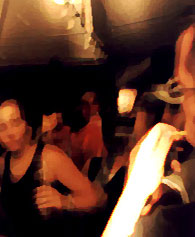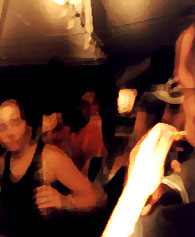High-energy dancing, loud music: lights, camera and action! The party and club scene is fast paced, exciting and on the edge. But taking drugs may put your health on the edge as well -- and I'm talking about real life, not the movies.

· What are the health risks and possible toxic effects of the drugs?
· Is it safe to mix them with alcohol?
· How do they affect sexual desire, performance and enjoyment?
Dangerous Risks
Drugs popular on the club scene are usually stimulants, hallucinogens or sedatives. Some are old familiar social drugs, whereas others may be unfamiliar in some locations.
Because most of these substances are synthesized under illegal and primitive conditions, they may have impurities, unknown contaminates and byproducts with unpredictable actions.
One common practice at clubs and parties is combining different drugs, either taken one at a time or in pre-made mixtures known as Roles or dose-paks. These combination highs are unpredictable and you often have no idea what is in them or how the recipe will affect your brain chemistry. One Role might produce a mellow effect with enhanced communication, improved dancing skills and relaxed attitude, while another Role from the same source the next night might throw you into a panic attack or a coma. Roles are probably responsible for some of the high-profile celebrity deaths on the club scene.
Using these drugs, especially the stimulants, with poppers is another major risk, especially for gay men. Poppers already cause dramatic rises in blood pressure, and combined with methamphetamine or Ecstasy, they can cause heart attack, stroke or sudden death. No real research has been done on the combination of club drugs and Viagra, but theoretically similar problems may occur.
Even without combining, party drugs can be very dangerous. There is another serious concern about the interaction between club drugs and antiretroviral medications used to treat HIV/AIDS. Plus, if you use sedative drugs like GHB and Rohypnol, you may forget to take your HIV medications. Skipping doses can lead to dru resistance.
You are also more likely to engage in unsafe sexual encounters when you use drugs because drugs interfere with your judgment. This puts you at greater risk of getting (or giving someone else) a sexually transmitted disease (STD) including HIV.
Popular Party Drugs
Ecstasy (also known as XTC, X, MDMA, Adam, Clarity, Essence, Stacy, Lovers, Speed, etc.)
Ecstasy is methylenedioxymethamphetamine, a synthetic stimulant which is probably the most well known and easily available drug on the party circuit. It can be taken in pill or liquid form, or combined with other drugs. Since it contains methamphetamine, it can have a strong stimulant action on the body, resulting in rapid pulse, racing thoughts, increased energy, sweating and excitement. In some people it can cause anxiety, extreme fearfulness, paranoid ideas or panic attacks.
Ecstasy also has a mild hallucinogenic effect. It can cause perceptual distortions which can be pleasurable (lights brighter, colors more vivid, music throbbing), unpleasant or downright terrifying (objects moving forward to crush you, faces menacing, rooms closing in). When you are on ecstasy, noises may seem too loud and voices may seem hostile and threatening. A bad trip on Ecstasy can last two to six hours or longer in some people.
Herbal Ecstasy (also known as Cloud 9, Herbal Bliss, Rave Energy, Herbal X, Spirit, GWM, Ultimate Xphoria, etc.)
Herbal Ecstasy is not a specific substance, but it is usually a mixture of several herbs and over-the counter stimulants including Ma Huang, Kola Nut, ephedrine, pseudoephedrine and caffeine. It is sold over the internet and at some health food stores. There is no reliable way to know what is in any given batch of Herbal Ecstasy because it is not regulated by the FDA. It tends to have less hallucinogenic effect than Ecstasy but it does have unpredictable stimulant symptoms. Usually it is short-acting.
Ketamine (also known as Special K, Vitamin K, Super K, Cat Valium, Killer Weed, New Ecstasy, etc.)

Rohypnol (also known as Roofies, Rophie, Roche, Roach, Rope, R-2, Run-Trip-and-Fall, Mexican Valium, Forget-Me, etc.) Rohypnol is flunitrazapam, a benzodiazepine sedative manufactured by Roche, Inc. It is not available by prescription in the U.S., due to it's severe side effects, primarily amnesia and excessive sedation. It is the drug most often associated with date rape. It is made in a pill form and is legal in Mexico. The pills dissolve readily in alcohol, so Rohypnol can be added to your drink without your knowledge. After the drug starts to take effect, there is often a loss of memory for the rest of the evening, and you may even be sexually assaulted and not remember.
Some people take Rohypnol for the alcohol-like buzz. Combined with alcohol, it has caused a coma and death. Rohypnol can be addictive.
Other, more familiar stimulant drugs are popular at some clubs, raves and circuit parties. These include cocaine, methamphetamine (also known as Crank, Speed, Crystal, Glass, etc.) Smokeable cocaine is usually called Crack, Rock or Base, while methamphetamine for smoking is known as Ice. Drugs prescribed to treat attention deficit hyperactivity disorder, such as Ritalin (methylphenidate), Adderall (methamphetamine and dextroamphetamine) and Dexadrine (dextroamphetamine) are also popular in some areas. Diet pills such as Fastin and Ionamine (phentermine) are also sometimes abused.
Old favorite drugs with sedative effects that are often used on the party scene include alcohol (Yes, Virginia, it is a drug!), Valium, Xanax, Klonopin, heroin and Dilaudid. All of these drugs can lead to addiction. If you do have an addiction to one of these drugs -- which may occur after only a few uses -- withdrawal symptoms can occur when you stop using the drug.
Dextromethorphan, found in some cough medicines, has sedative and hallucinogenic effects in large doses, but can cause seizures and death.
LSD (lysergic acid diethylamide, Acid, Blotter, Cubes, Dots, etc.) is also making a big comeback. It is a powerful hallucinogen and it causes gross distortions of vision, hearing and smell, though rarely real hallucinations. It can cause major mood swings and/or panic.
Getting Help
Because of the unpredictable reaction to these drugs and combinations of drugs, and the growing number of reports of sexual assaults, severe injuries and deaths among club goers, the National Institute on Drug Abuse (NIDA) is launching a major effort to educate people about the risks and dangers of club drugs. NIDA Director, Dr. Alan Leshner, has also recruited support in this effort from other concerned medical organizations and consumer groups. The Gay and Lesbian Medical Association (GLMA) has adopted a new policy encouraging these educational efforts by government and private agencies. For more information about the health risks of club drugs, check out the new website of the NIDA (http://www.clubdrugs.org) or call NIDA Infofax at 1-888-644-6432.
